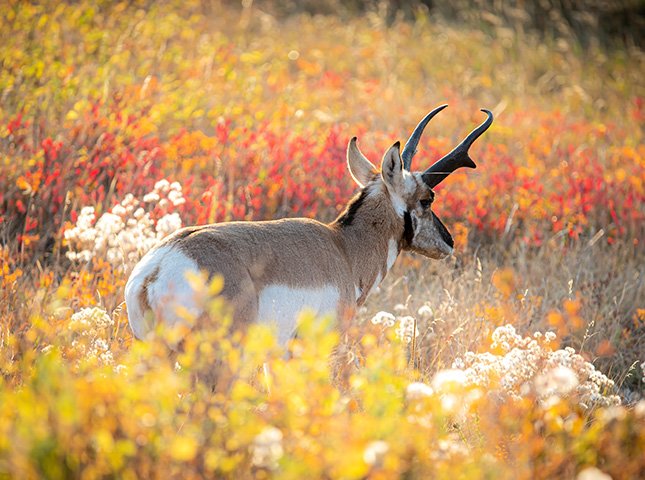Deer have limited vision. Let’s explore what colors they can see. It’s known they perceive the world in two colors: blue and green. Red and orange hues are difficult for them to see. Red is almost invisible to them. This is because they lack photoreceptor cells that process red light. Hunting practices use this by wearing hunter-orange clothing, which appears as a gray or brown to deer. Research by Neitz and Geist at UCSB studied deer vision and concluded red is a challenge for them. Now, we can better interact with deer and create wildlife-friendly surroundings. This helps us live peacefully with them.
Table of Contents
The Spectrum of Deer Vision
Deer have a vision which is different from us humans. While we can see a range of colors from 3 primary colors (red, blue and green), deer can only see 2 types of color receptors. Blue shades appear to be their weakness, as their eyes can’t detect objects or movement in the blue spectrum.
This matters- hunters can use this knowledge for their camouflage gear or blinds. Researchers can use it when designing experiments or observing deer.
We can leverage this insight effectively. It can help us in recreational or scientific endeavors. So remember, if you’re in a place with deer, use colors they can’t detect.
Colors Deer Cannot See
Deer have dichromatic vision; they only perceive two colors: blue and green. They cannot see red due to the lack of red cone receptors in their eyes. This means that bright, red objects can blend into their surroundings. Camouflage patterns incorporating reddish tones can hide hunters from deer. A hunter once painted his hunting blind orange, but deer didn’t notice it!
We can use this knowledge of deer’s color vision to gain insights into their behavior. We can also better understand how to coexist with them in their natural habitat. For example, we can use strategies such as camouflage and visibility.
Strategies for Using Unseen Colors
Deer have limited color vision. They can see some colors, like blue and yellow, but others remain hidden. Hunters and wildlife enthusiasts can use this to their advantage.
Hunters can incorporate unseen colors into their gear or equipment, camouflaging themselves with colors that blend into the environment.
Using bait or lures with unseen colors can also draw deer closer without suspicion. It’s important to understand which colors are unseen by deer to be effective.
Photographers and nature observers can use these colors too. By incorporating them into their compositions, they can create captivating images from a deer’s perspective.
It’s important to stay informed on animal vision research. This will give outdoor enthusiasts an edge over their competition.
Remember the power of unseen colors. Embrace these strategies and unlock new opportunities in your outdoor pursuits.
Conclusion
Deer have difficulty perceiving the color orange. So, hunters use it to stay unnoticed in the wild. This is because deer lack certain types of color receptors in their eyes. Making it hard to recognize different shades of orange.
They also have poor vision in low-light. So, they struggle to judge distances accurately. This is dangerous for them, as they can’t avoid danger such as oncoming vehicles or predators.
However, there’s no sure-fire way to be invisible to deer. But, understanding their vision makes it easier to avoid detection. Choose colors they have trouble perceiving, like orange. And, be mindful of their limitations in low-light. This helps minimize our impact on their habitat.
Next time you go outdoors, remember deer’s unique vision. Respect it and adapt our behavior. This is the only way we can coexist peacefully with wildlife. Let’s strive for a world where humans and animals can live without fear or harm.
Frequently Asked Questions
FAQs about what color light deer cannot see:
1. What color light can deer not see?
Deer cannot see the color orange and some shades of red. They have difficulty perceiving longer wavelength light, making these colors appear gray or green to them.
2. Why can’t deer see certain colors of light?
Deer have different types of color receptors in their eyes compared to humans. They are most sensitive to shorter wavelength light, such as blues and greens, but struggle to distinguish longer wavelengths, like oranges and reds.
3. Do deer see the color green?
Yes, deer can see the color green, but it appears more muted to them. Their vision is best adapted to perceive shades of blue and green, while other colors may blend together or appear differently to them.
4. Is it true that deer cannot see the color orange?
Yes, it is true. Deer lack the ability to differentiate the color orange. To them, it may look like a shade of gray or brown. Hunters often wear orange clothing to remain visible to other hunters while minimizing detection by deer.
5. Can deer see the color red?
Deer struggle to see certain shades of red. The color red appears as dark gray or brown to them due to their limited sensitivity to longer wavelengths. Therefore, red clothing or objects may not stand out to deer as much as they do to humans.
6. What colors are most visible to deer?
Deer have better visual acuity for shades of blue and green. These colors are more easily discernible to them compared to oranges, reds, and some other longer wavelength colors. Camouflage patterns and earth tones blend better with the natural environment as perceived by deer.


